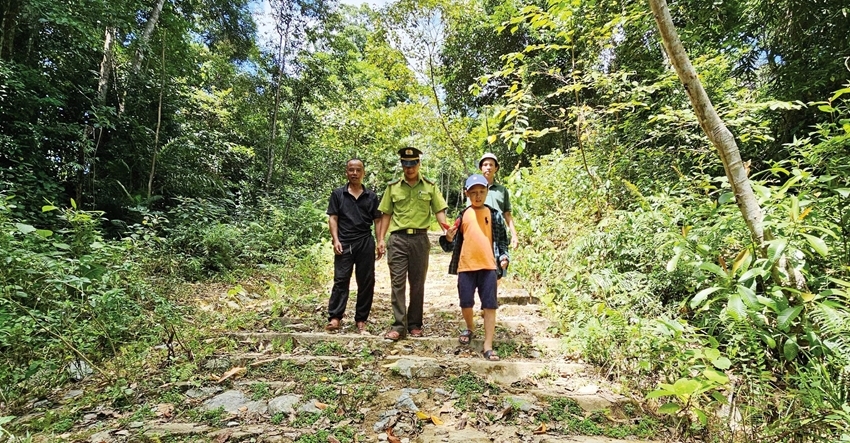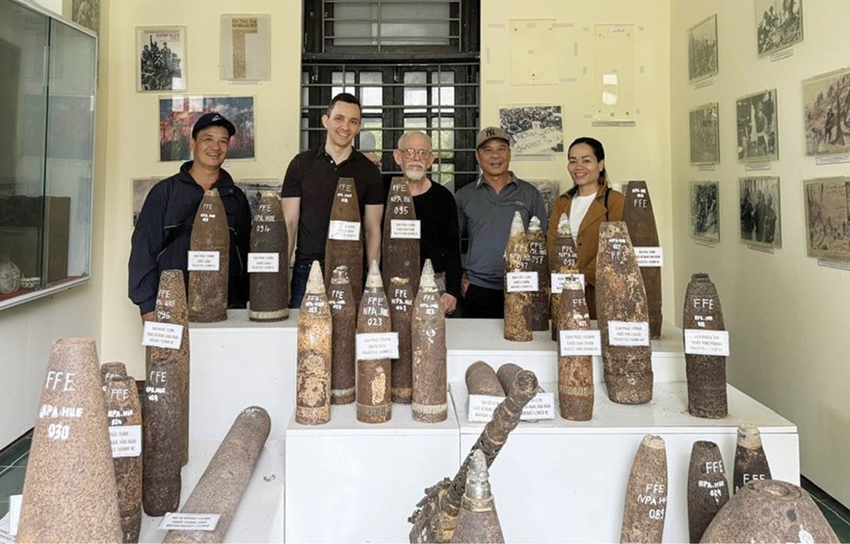 |
| There are over 850 steps leading to the top of Hill 937 |
“Still Haunting”
Books and films have spoken much about Hamburger Hill. In a documentary footage, Sergeant James Spears, then only 19 years old, told a foreign news agency reporter: “Have you ever been in a meat grinder? We were minced into pieces by extremely accurate machine guns.” That shocked, angry, helpless face still haunts viewers. Many foreign tourists coming here have also heard about “Hamburger Hill” from various channels.
Walter, an English tourist, says: “I think any Westerner at my age or even a bit younger would have seen the movie about Hamburger Hill, the famous war film. If you've seen that movie or read any books about the battle on ‘Hamburger Hill’, you'll want to come here as soon as you’re in Hue. It’s wonderful to come here and connect, compare with what you’ve read and heard. Being able to explore and challenge myself climbing the mountain, I feel invigorated. It’s very exciting!”
 |
| The artifact exhibition room at Hamburger Hill preserves many images and artifacts related to the battle. Photo provided by the character |
Mr. Robert, a 64-year-old man from New Zealand, explains his reason for coming to this summit: “My company once worked with some veterans. They told me so many stories about Hamburger Hill that made me curious. I used to watch all the news about the Vietnam War on TV from 1968-1969, including reports about ‘Hamburger Hill.’ At 20, I read books about the Vietnam War, becoming more interested in history. I always told myself I had to come to Vietnam, set foot at the place where the battle considered the toughest since World War II took place.”
Among the thousands of foreign visitors to A Biah each year, there are elderly American veterans are returning to their former battlefield, back to where they and their friends shed blood. Kenneth Edd Miller, an American, brought his grandson William Wei Hao Miller back to A Luoi for authentic experiences. Kenneth Edd Miller had participated in the battle on Hill 937 and recognized his friends in the series of photos in the exhibition room. However, he dared not express it, fearing that local people might still hold grudges. It wasn’t until he set foot on the peak of Hill 937 that the 72-year-old man burst into tears, unable to contain his emotions. Old memories just poured out. He told his grandson and the tour guide as if wanting to release long-suppressed hidden traumas. He still keeps many relics related to the battle, as it was too horrific, haunting, causing him endless remorse. He said that coming there fulfilled the wish of his old age”!
“Although the roads are difficult to travel and climbing is hard, most foreign visitors are impressed and like this destination. Although there aren’t many traces left, viewing 90 artifacts and photos in the Exhibition Room, talking with locals, visitors gain new perspectives and information,” shares a tour guide from a company specializing in old battlefield tours.
Appreciating the value of peace
In recent years, many groups have come to A Biah to offer incense and hold memorial services. Hundreds of elderly people walk while praying. Their feet tirelessly move towards the memorial stele. While most young people look at the slope up to the summit and lose heart, the old veterans walk with a familiar experience, faith and mental strength.
Major General Vo Chot, Former Deputy Commander, Chief of Staff of Military Command - Region IV, Deputy Regiment Commander of Regiment 1, 324th Division at the time of May 1969, has returned to A Biah with his comrades many times since the liberation day. In his backpack, he always has a map and a list of martyrs who fell here. Once, he stood on the summit looking down at the A So Valley with tears in his eyes due to the frustration of not finding his comrades. “The fighting here was indescribably fierce. Many comrades and compatriots fell to protect the Fatherland, to build peace. If I no longer have the strength to search, I will hand over the list, map, marked positions... to those responsible to continue this mission,” shared he.
Vien Dang Phu, a Ta Oi ethnic guide in A Luoi who has led many domestic and foreign tourist groups here, says that young people are curious about the famous historical site. The elderly remember their comrades, thinking about the war that took place in Vietnam. International veterans often question why Americans participated in that war, then silently contemplate. Foreign visitors initially hesitated to mention the war and what the Americans did. They are very reluctant to open up...
He recounts the most impressive visitor: “His name is George Black - a Scottish writer and journalist living in America interested in post-war reconciliation in Vietnam. His friend Bill, who directly piloted the plane shot down in A Luoi before April 1967. George Black reached the top of A Biah Hill, stopped, pulled out a harmonica, and played in the mountain wind. Before leaving, he took a handful of soil to bring back home for the relatives of veterans - those who couldn't come to where their loved ones had fallen.”
Consistently attached to the Hamburger Hill tour, Ms. Pham Thi Tuyet, a staff of the A Luoi Culture and Information Department, comments: “Visitors are very interested in this place that once shook the Western world. The war has long passed, but its lessons are still engraved by many generations. The more people come here, the more they appreciate the value of peace.” As for Ms. Le Thi Them, Head of the Department, in 2023, the total number of visitors to A Biah was about 10,000. In the first months of 2024, this place welcomed 5,000 visitors, including about 2,000 internationals. According to the local development orientation, Hamburger Hill is poised to become a tourism satellite of A Luoi district and a crucial connecting point in developing historical relic tourism combined with eco-tourism.
On this return trip to A Biah in early autumn, I met Bien, a young forest ranger, and Buong, a cadaster officer of Hong Bac commune, on their duty to protect the forest. The two kindly showed us how to recognize some wild tubers and fruits that can quench thirst. Talking with Buong, I learned that he has two uncles who participated in the battle on Hamburger Hill. His first uncle, Mr. Le Viet Hoang, sacrificed and was gathered at the A Luoi Martyrs Cemetery. The second uncle, Mr. Le Van Xich, who had two near-death experiences on Hill 937, now lives about a kilometer from this hill. “He rarely interacts with outsiders, just focuses on farming and gardening. Perhaps the battle on A Biah has seeped deep into his flesh and blood, so he often mentions old stories and visits the hill to see his comrades,” told Buong.
A Biah in the Pa Co language means a place where all animals take shelter. Now, this place has become a symbol of patriotism, the will for independence, and the indomitable fighting spirit of the Vietnamese people.
American press on May 25, 1969, called A Biah the “Hamburger Hill” of American paratroopers. The Life magazine published true photos of 241 American soldiers who died in one week at this summit. The battle on Hamburger Hill caused so many American casualties that Senator Kennedy at the time considered: “The operation on Hamburger Hill was mad and irresponsible.”
